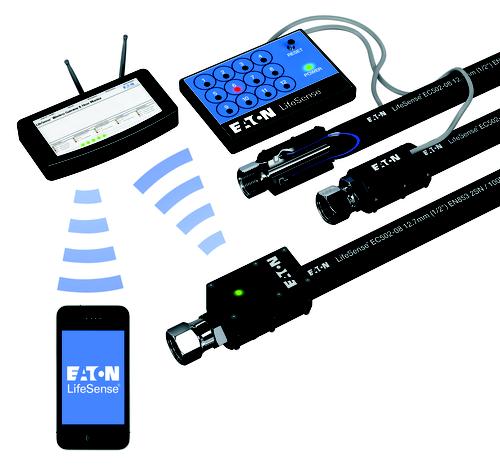A Look at the Impact of IoT on Motion Control and Fluid Power
July 10, 2015

The Internet of Things is a growing trend across all industries. As more data is made available, translating that data into information and knowledge can help tremendously improve system functions and yield new insights into end users' operations. In the hydraulics industry, connecting components to the IoT can turn traditional pumps, motors, and valves into "smart" pumps, motors and valves, which are able to deliver diagnostic data directly into the hands of end-users, OEMs, and developers. Through steady and continuous change, adoption of IoT has continued to grow and will continue to contribute to innovations in mobile and industrial machines as intelligent devices and wireless communications become the industry norm.
Hydraulics and the Rapid Growth of IoT
The concept of electrohydraulics -- integrating electronics and controls into hydraulic or mechanical hydraulic solutions -- is developing across the industry. Electronic control hardware has been getting more complex over the past few years, and integrating electronics into traditionally hydraulic or mechanical hydraulic solutions allows greater connectivity between products. This allows systems to seamlessly communicate internally and deliver data externally. The biggest changes are seen in the advancements of control software and algorithms. Controls are key in power management, which helps manage fuel consumption by helping machines make more intelligent decisions about when and where to use power.

While IoT-enabled components continue to become an industry establishment for hydraulic equipment, gathering and analyzing data from these components is changing how companies deliver information. As machine functions continue to advance across the industry, IoT has enabled operators to measure system efficiency gathered by the "smart" product itself. Knowing the work profile and energy consumption of an industrial machine, for example, can help engineers make design changes that will maximize efficiency and productivity, which effectively helps save owners and operators from costly, unexpected downtime. Most hydraulic systems are long-term, capital investments, and with IoT components measuring system performance, servicing and maintenance for these smart machines help prolong the product lifecycle.
With the influx of data caused by more and more IoT-integrated hydraulic products, the fluid power industry is making significant investments into back-office tools and infrastructure to handle the massive amounts of data being generated and collected.
Software on the Rise
As software for machine control continues to develop, engineers are actively researching how future iterations of hydraulic products will deliver information across networks and through the cloud. Components that are naturally more sensing, such as control elements, may seem best suited to IoT connection. However, components that have not traditionally seen controls -- such as hoses -- can now be tied in and provide significant value. With data available in the cloud, information can be better tracked and utilized, giving customers access to needed information. In addition, this gives companies insight into how customers are using products, allowing for more innovative solutions designed based on real customer utilization.
In mobile applications, advanced valves with built-in electronics allow for onboard pressure sensing and internal position sensing -- and come with built-in software to perform specific functions. By measuring fuel consumption and system functionality in environments utilizing mobile hydraulic machinery, IoT helps end-users continuously look for component efficiencies as well as actionable items to make machine operators more productive.
Connecting components and enabling predictive diagnostics does not mean much unless software exists to help turn data into information and then alert users to issues raised by that information. As smart components are integrated into both industrial mobile hydraulic systems, ease of machine use has emerged as a common theme across the industry. For industrial applications, machine operators can monitor the efficiency of automated functions while IoT-enabled devices simplify the configuration process of automated methods.
How Much Is Too Much Information?
The IoT is growing rapidly across the fluid power industry, particularly in the industrial market. The continuum of available data can help end-users know everything from the energy consumption of a machine to the number of automated processes the machine has carried out on a given work day -- if machine owners and operators are prepared to handle the data influx.
There are huge advantages in having massive amounts of information available with the click of a button. Machine designers, engineers, manufacturers, and end-users know more than ever about how machines are operating. Too much data can be overwhelming, though, unless customers are prepared to use that data to realize value from smart components. Complexity usually adds cost, which adds risk, making it key to add complexity where it will be the most valuable.
MORE FROM DESIGN NEWS: LifeSense Hose Monitoring
Handling these massive amounts of data requires training to optimize new IoT integrations. Technology is rapidly expanding, and end-users must prepare to handle the software and electronics that come with "smart" components, plus the data they provide. This has spawned an entirely new sub-class of technical, engineering, and science employees across the workforce -- with data scientists becoming increasingly utilized across manufacturing. Employees that are skilled at distilling the noise into intelligible and useful knowledge play a critical role in maximizing the value of integrated smart components.
Big Data is paving the way for manufacturing groups to stay competitive in today's rapidly developing global economy. Industrial businesses both small and large are integrating huge quantities of data from their machinery in an effort to reduce energy costs, improve production times, and increase their bottom lines.
About the Author(s)
You May Also Like





